Cake Decorating Classes Galax Area

Cake decorating is one of the sugar arts that uses icing or frosting and other edible decorative elements to make plain cakes more visually interesting. Alternatively, cakes can be molded and sculpted to resemble three-dimensional persons, places and things.
Cakes are decorated to mark a special celebration (such as a birthday or wedding). They can also mark national or religious holidays, or be used to promote commercial enterprises. However, cakes may be baked and decorated for almost any social occasion.
History [edit]

Cake decorating originated in 17th century in Europe.[1] During the 1840s, the advent of temperature-controlled ovens and the production of baking powder made baking cakes much easier.[2] As temperature control technology improved, an increased emphasis on presentation and ornamentation developed.[1] Cakes began to take on decorative shapes, were adorned with additional icing formed into patterns and flowers, and food coloring was used to accent frosting or layers of cake.
There is no official answer to who specifically began cake decorating. Cakes have been decorated for many centuries for special occasions. Wedding cakes have the longest traditions and are considered the most artistic form, and Christmas cakes being decorated began in the eighteen centuries, they were consider Twelfth Night Cakes and were only baked by the rich for the rich. [3]
Even though baking from scratch decreased during the latter part of the 20th century in the United States, decorated cakes have remained an important part of celebrations such as weddings, anniversaries, birthdays, showers and other special occasions.[4]
Types of decorations [edit]
Cake decorations are adornments or embellishments that are placed on top or around cakes. Cake decorations can be made of edible material or food-safe plastics.

A fondant rose edible cake decoration
Fondant, also known as sugar paste or ready roll icing, exists in many different colors, and it is usually easy to handle once prepared properly. It must be rolled out with cornstarch to avoid sticking to any surface and to smooth it out. Once completely smooth and thin enough, cake decorators are able to mold fondant into many different artistic expressions. Many of these expressions are also taught in professional cake decorating classes. Fondant is primarily used to cover cakes, but it is also used to create individual show pieces for cakes. Because it is heavier than traditional knife-spread frosting, extensive fondant artistry may require a heavy cake consistency for support.
Royal icing is a sweet white icing made by whipping fresh egg whites (or powdered egg whites, meringue powder) with icing sugar.[4] Royal icing produces well-defined icing edges especially when decorating biscuits/ cookies and is ideal for piping intricate writing, borders, scrollwork and lacework on cakes. It dries very hard and preserves indefinitely if stored in a cool, dry place, but is susceptible to soften and wilt in high humidity.
Marzipan is often used for modeling cake decorations and sometimes as a cover over cakes, although fondant is more preferred.

A bow made from gum paste
Gum paste, also known as florist paste, is an edible, brittle material that dries quickly and can be sculpted to make cake decorations such as flowers or molded designs.[5]
Modeling chocolate is a chocolate paste made by melting chocolate and combining it with corn syrup, glucose syrup, or golden syrup. The chocolate is formed into a variety of shapes and structures that cannot be easily accomplished with other softer edible materials such as buttercream frosting, marzipan, or fondant. Modeling chocolate can be made from white, dark, semi-sweet, or milk chocolate.
Edible ink printing is also used in decorating cakes. After breakthroughs in nontoxic inks and printing materials in the early 1990s,[6] it became possible to print images and photographs onto edible sheets for use on cakes. It is the process of creating preprinted images with edible food colors onto various confectionery products such as cookies, cakes, or pastries. Designs made with edible ink can be created with an edible printer, a specialty device which transfers an image onto a thin, edible paper. Edible paper is made of starches and sugars and printed on with edible food colors. Originally introduced as a specialty service provided by bakeries, this technology can now be used by home consumers using the specialized paper, ink and printers.
Techniques [edit]
Decorating a cake usually involves covering it with some form of icing and then using decorative sugar, candy, chocolate or icing decorations to embellish the cake. But it can also be as simple as sprinkling a fine coat of icing sugar or drizzling a glossy blanket of glaze over the top of a cake like a mirror cake style that uses a glaze of gelatin, sugar, water, and sometimes chocolate.[7] A cake turntable (or rotating tray) can be used to facilitate the process.
Icing decorations can be made by either piping icing flowers and decorative borders or by molding sugar paste, fondant, or marzipan flowers and figures. An embossing mat is a tool for cake decoration[8] that creates embossed effects on the top of cakes, cupcakes, or similar items. The user presses the mat down into cake dough or icing and the pattern embossed in the mat is transferred to the item.[8] Embossing mats are often made of silicone rubber or similar flexible polymers.[ citation needed ]
"Naked Cakes" are a popular trend, as of 2020. In this decorating style, fillings are used between the cake layers but the outside is left unfrosted, or sparsely frosted with much of the cake itself still visible between and through the frosted areas. Naked cakes are often decorated with icing sugar or fresh flowers on top. They are especially popular as wedding and engagement cakes.[ citation needed ]
It may be necessary to secure cake layers in place to prevent sliding or falling, especially for large cakes with several layers. Various forms of wooden skewers or dowels and plastic straws are commonly used for this purpose.[9]
Large and complex structures can be made by cutting shapes out of cake and piecing them together (often secured together with many non-edible reinforcements). Pre-formed baking pans make it easy to create cakes in non-traditional shapes. Though while useful for producing multiple cakes of the same general shape, they do not have the endless customizability of hand-cut building blocks. Fondant and marzipan structures can also be used to modify the overall shape of a cake.[ citation needed ]
As an art [edit]
Cake decorating has become a unique art form, with examples ranging from simply decorated single-layer cakes, to complex, multi-layered three-dimensional creation with extensive edible decorations.
In popular culture [edit]
- Food Network's Ace of Cakes features baker and former street-artist, Duff Goldman, and his shop, Charm City Cakes.[10]
- WE's Amazing Wedding Cakes is a television series featuring several cake decorating companies across America and focuses on the crafting and design of the cakes.
- Cake Wrecks is an entertainment photoblog featuring user-submitted images of "unintentionally silly, sad, creepy or inappropriate" cakes.[11]
- TLC's Cake Boss features baker Buddy Valastro and his shop called Carlo's Bake Shop in Hoboken, New Jersey.
- Netflix's Nailed It! is a competition show in which amateur bakers attempt cake decorating.
Gallery [edit]
-

A cake decorated to resemble a child's dress
-
Lady's evening bag cake with edible frosting
-
Cake with large cabbage roses
-
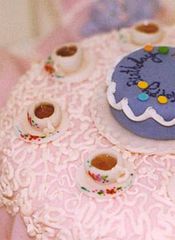
Detail of hand-painted miniature cups in sugar with sugar lace tablecloth
-
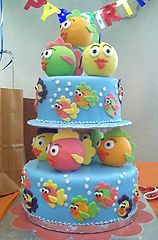
Birthday cake for one-year-old
-

-
Guitar cake with edible frosting
-
Chocolate cake decorated with foliage and chocolate roses
-

Science cake with Bakelite oven chocolate cake top
-

An International Space Station-themed NASA slab cake for students at Kennedy Space Center
-

A fondant-covered cake depicting a sewing kit
-
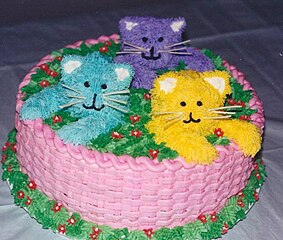
Basket of kittens cake
-
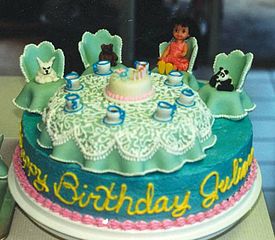
Birthday party birthday cake
-

Chocolate cake with roses
-

A cake sculpted to look like a cheeseburger with fries
-

A cake decorated to look like a pumpkin with mice living in it
See also [edit]
- Cake shop
- Couverture chocolate
- Dessert sauce
- Huamo
- Pastry chef
- Pâtisserie
- Food presentation
- Food photography
- Sprinkles
- Sugar substitute
- Wedding cake
- Cake
References [edit]
- ^ a b Beckett, Lynlee (2015). "Cake Decorating: History, Overview and Techniques". Craftsy.com. Craftsy and Sympoz Inc.Terms of Use. Archived from the original on September 5, 2015. Retrieved March 30, 2015.
- ^ The Food Museum Online Exhibit, Accessed 2007-05-20 (archived link, February 3, 2010)
- ^ The Essential Guide to Cake Decorating. Murdoch Books Test Kitchen. 2001. p. 8.
- ^ a b Cake decorating
- ^ "What is the difference between florist paste, gum paste, fondant, Mexican paste etc?". PrettyWittyCakes.com . Retrieved March 30, 2015.
- ^ Andel, Tom (August 1, 1997). "Get contractors on your team". Transportation & Distribution. Penton Pub. 38. Archived from the original on October 3, 2015.
- ^ Saelinger, Tracy (12 May 2016). "These stunning, shiny cakes are making the internet drool". Today.com. Retrieved 10 January 2019.
- ^ a b Sullivan, K. (2013). Step-by-Step Cake Decorating. DK Publishing. p. 50. ISBN978-1-4654-1822-7 . Retrieved January 26, 2017.
- ^ Phillips, Sarah. "Cakes - Stack and Support Layers". craftybaking.com.
- ^ Bake it as a man
- ^ Hochman, David (October 13, 2009). "When the Icing on the Cake Spells Disaster". The New York Times. nytimes.com. Retrieved October 20, 2009.
External links [edit]
![]() Media related to Cake decoration at Wikimedia Commons
Media related to Cake decoration at Wikimedia Commons
Cake Decorating Classes Galax Area
Source: https://en.wikipedia.org/wiki/Cake_decorating
Posted by: rodriguezrecke1963.blogspot.com


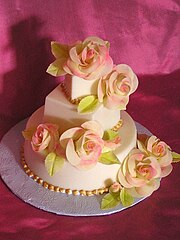


0 Response to "Cake Decorating Classes Galax Area"
Post a Comment